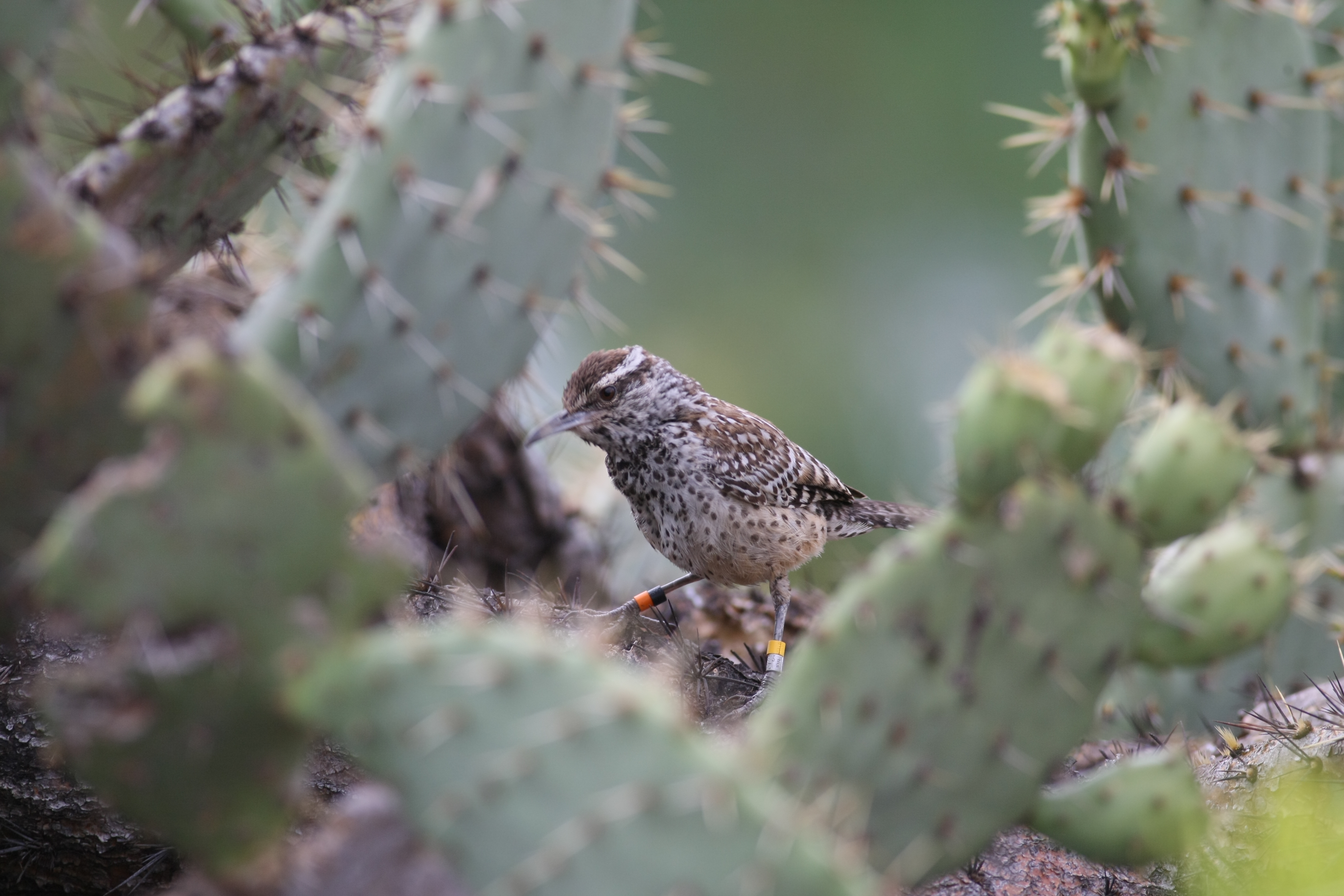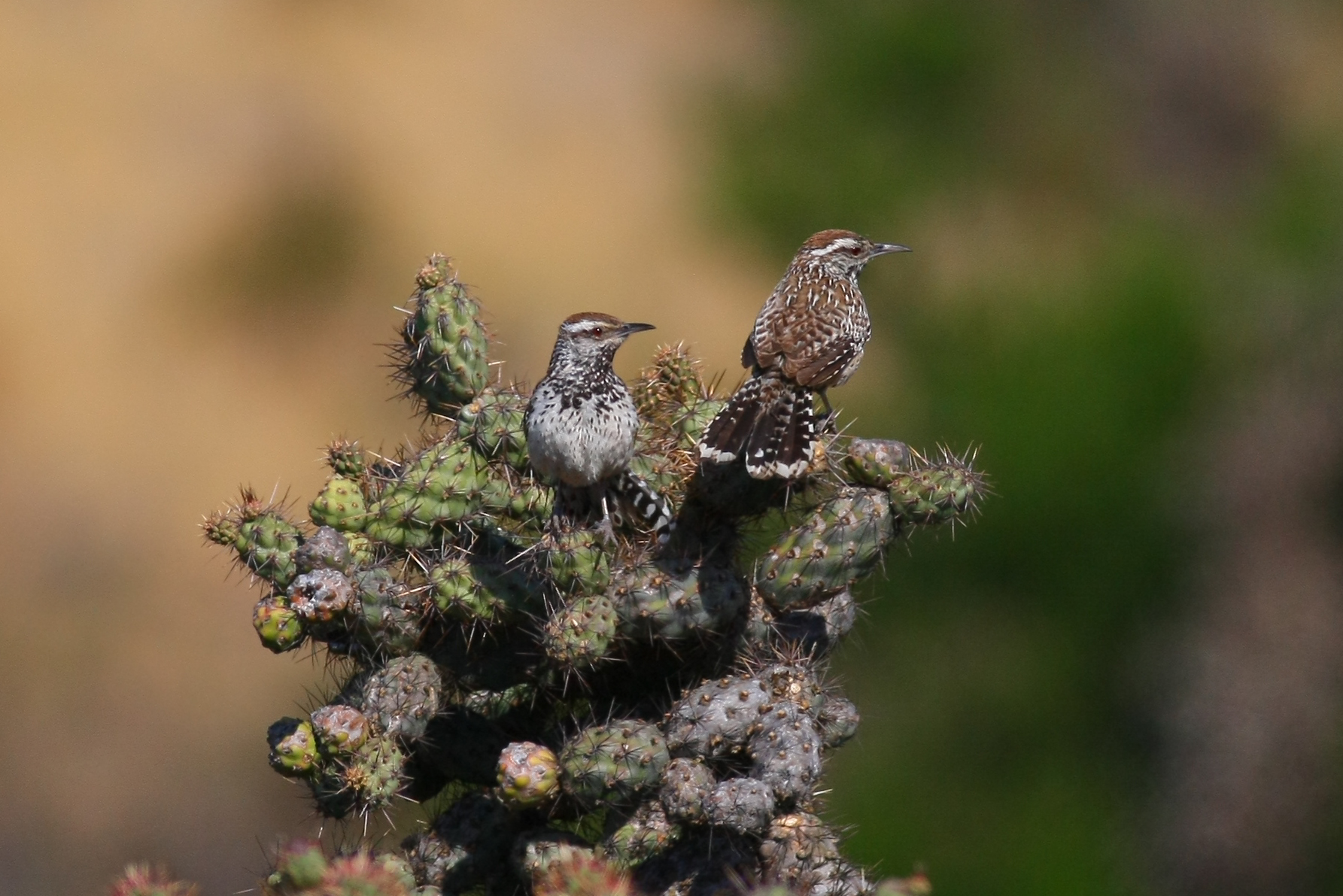Current Distribution Rangewide
Resident species from S. Calif. south to S. Baja Calif., S. Nevada, SW Utah, W. and south central Arizona, S. New Mexico, and central Texas south to Mexico [1].
Known Populations in San Diego County
In San Diego County, the coastal cactus wren is known to occur at Lake Hodges/San Pasqual Valley, Lake Jennings, South Sweetwater Reservoir/San Miguel Ranch, and Salt Creek/Otay Mesa, Camp Pendleton/ Fallbrook NWS; San Pasqual Valley and Lake Hodges; San Diego and El Cajon; and Otay River [3, 4].
List Status
CSC
Habitat Affinities
Closely associated with three species of cacti and occurs almost exclusively in thickets of cholla (Opuntia prolifera) and prickly pear (Opuntia littoralis and Opuntia oricola) dominated stands of coastal sage scrub below 457 meters in elevation on mesas and lower slopes of the coast ranges [2].
Taxonomy and Genetics
Eight subspecies are recognized with the subspecies falling into roughly two groups the affinis group (peninsular forms) and brunneicapillus group (continental forms) [2]. Recent USGS genetic studies showed genetic differentiation between four distinct genetic clusters: Orange County and MCB Camp Pendleton/ Fallbrook NWS; San Pasqual Valley and Lake Hodges; San Diego and El Cajon; and Otay River [3, 4].
Seasonal Activity
Exhibits year-long, diurnal activity. The species is not migratory [5].
Life History/Reproduction
Breeds from March into June; clutch size is 4-5 eggs, with a range of 3-7 eggs [6]. Two broods per season are common; incubation is 15-18 days, by the female only [7]. The altricial nestlings fledge at 17-23 days, with an average of 21 [8]. The young may return to roost in the nest after fledging. The young become independent at about 1 mo after leaving the nest; sometimes the young help feed the young of later broods [6]. Overall adult survival rate reported as 50.6% during a six year study [7].
Diet and Foraging
Forages on the ground and in low vegetation for insects and other small invertebrates, cactus fruits and other fruits, seeds and nectar [7, 9]. Fruits make up 15-20 percent of the annual diet [10].
Dispersal
Generally considered to have low dispersal; in Arizona, of 55 nestlings banded, 41 dispersed from the natal site by 45 days postfledging; males remain near the natal site, usually dispersing only as far as parental territorial behavior dictated [2].
Threats
The most important threat to coastal cactus wren has been the loss and fragmentation of cactus scrub habitat as a result of urban and agricultural development [2]. A second primary threat is large wildfires that cause direct mortality of birds and destroy cactus scrub, which can take many years to recover [11, 12, 13, 14].Other threats include invasive plant species reducing open habitat for foraging, [15, 16] declines in productivity during drought, and predation by domestic cats, roadrunners, snakes, loggerhead shrikes, and especially Cooper's hawks.
Literature Sources
[0] 1. Terres, J. K. 1980. The Audubon Society Encyclopedia of North American Birds. Alfred A. Knopf, New York, New York. 1109pp. 2. Proudfoot, G. A. , D. A. Sherry, and S. Johnson. 2000. Cactus wren (Campylorhynchus brunneicapillus) No. 558. In The Birds of North America, A. Poole and F. Gill, Eds. Cornell laboratory of Ornithology, New York, and The Academy of Natural Sciences, Washington D.C.3. Barr, Kelly R., Amy G. Vandergast and Barbara E. Kus. 2012. Genetic Connectivity in the Coastal Cactus Wren. Data summary report prepared for the San Diego Management and Monitoring Program and the San Diego Association of Governments (SANDAG). 4. Barr, Kelly R., Amy G. Vandergast, and Barbara E. Kus. 2013. Genetic Structure in the Cactus Wren in Coastal Southern California. Data summary report prepared for the California Department of Fish and Wildlife. 5. Zeiner, D. C., W., F. Laudenslayer, Jr., K. E. Mayer, M. White. Editors. 1990. California's Wildlife. Volume 2. Birds. State of California, Department of Fish and Game. Sacramento, California. 731 pp. 6. Harrison, C. 1978. A field guide to the nests, eggs and nestlings of north American birds. W. Collins Sons and Co., Cleveland, OH. 416pp. 7. Anderson, A. H., and A. Anderson. 1960. Life history of the cactus wren. Part III: The nesting cycle. Condor 62:351-369. 8. Hensley, M. M. 1959. Notes on the nesting of selected species of birds of the Sonoran Desert. Wilson Bull. 71:86-92. 9. Bent, A.C. 1968. Life histories of North American Nuthatches, Wrens, Thrashers, and their allies. U.S. National Museum Bulletin 195. U.S. Government Printing Office. Washington, D.C. 10. Ehrlich, P. R., D. S. Dobkin, and D. Wheye. 1988. The birder's handbook. Simon and Schuster, New York. 785pp. 11. Bontrager, D. R., R. A. Erickson, and R. A. Hamilton. 1995. Impacts of the October 1993 Laguna Canyon fire on California Gnatcatchers and Cactus Wrens. Pp. 69-76 In Brushfires in California wildlands: ecology and resource management (J. E. Keeley and T. Scott, eds.). Int. Assoc. Wildland fire, Fairfield, WA. 12. Mitrovich, Milan J. and Robert A. Hamilton. 2007. Status of the Cactus Wren (Campylorhynchus brunneicapillus) within the Coastal Subregion of Orange County, California. Prepared for the Nature Reserve of Orange County. 13. Hamilton, Robert A. 2008. 2008 Surveys Cactus Wrens and California Gnatcatchers San Dieguito River Valley, San Diego County. Report prepared for Conservation Biology Institute. 14. Leatherman BioConsulting, Inc. 2009. Central Reserve Cactus Wren Habitat Assessment and Study 2008. Prepared for the Nature Reserve of Orange County. 15. Preston, Kristine L. and Dana Kamada. 2012a. Nature Reserve of Orange County: Monitoring Coastal Cactus Wren Reproduction, Dispersal and Survival, 2009-2011. Report prepared for California Department of Fish and Game, Local Assistance Grant #PO982013. 16. Kamada, Dana and Kristine Preston. 2013. Nature Reserve of Orange County: Coastal Cactus Wren Dispersal and Survival Surveys, Genetics and Parasite Sampling, and Arthropod Foraging Ecology in 2012. Annual Memorandum of Understanding report prepared for California Department of Fish and Wildlife.

